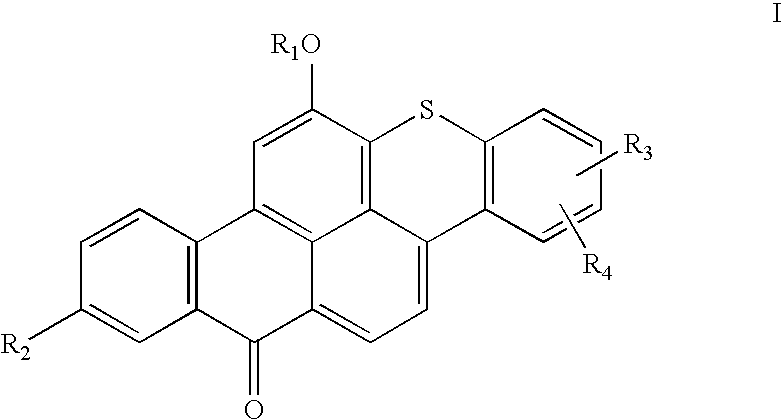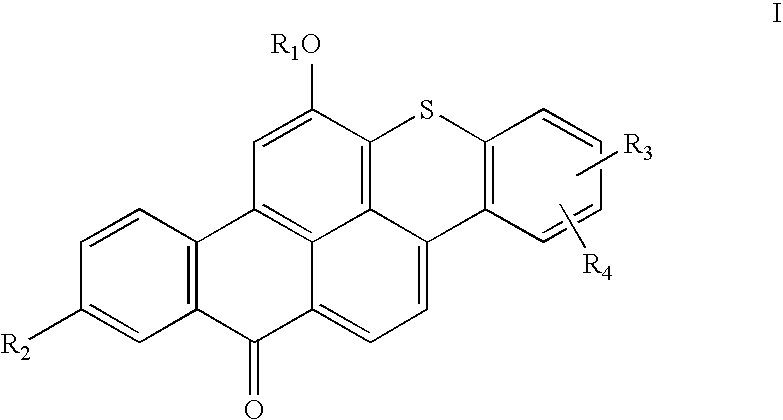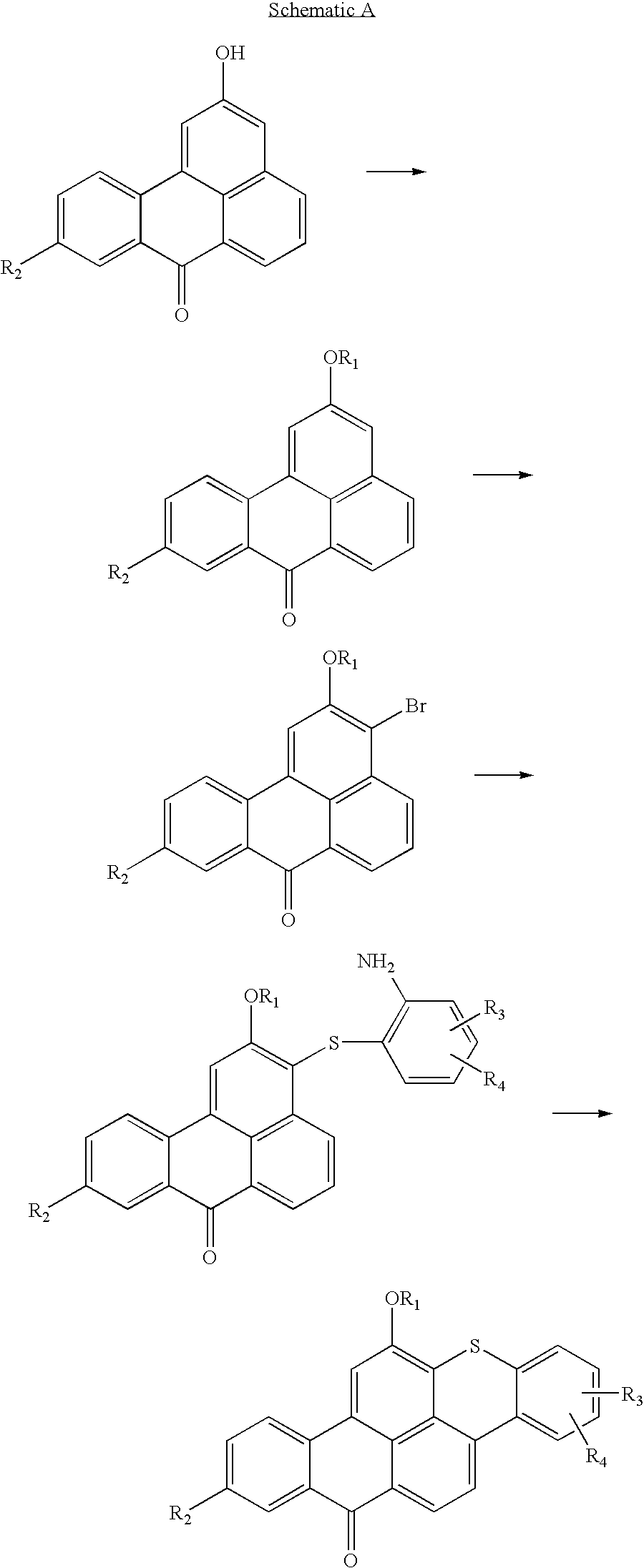Articles containing thioxanthone dyes
- Summary
- Abstract
- Description
- Claims
- Application Information
AI Technical Summary
Problems solved by technology
Method used
Image
Examples
example 1
6-n-Octyloxy-14H-anthra(2,1,9mna)thioxanthene-14-one
A. Preparation of Sulfate Salt of Anthraquinoyl Diazonium.
Into a three necked 0.5 liter round bottom flask, containing 150 ml of concentrated sulfuric acid and equipped with a thermometer and a mechanical stirrer, and immersed into an ice bath, 17 g (0.246 M) of finely ground sodium nitrite powder was added in portions, carefully maintaining the reaction temperature below 10° C. Upon the completion of the sodium nitrite addition, the ice bath was removed and the introduction of 50 g (0.224 M) of 1-aminoanthraquinone commenced. A slow rise in temperature was observed. Upon the completion of the 1-aminoanthraquinone addition (here the reaction mass color changed from yellow-green to reddish-brown), the reaction mixture was heated to 50° C. and held at 50° C. for 20 minutes, and then allowed to cool to room temperature.
The cooled reaction mixture was decanted after mixing in a beaker, into which 350 g of finely chopped ice had been pl...
example 2
6-[(2-Ethylhexyl)oxy]-14H-anthra[2,1,9-mna]thioxanthene-14-one
A. Preparation of 2-[(2-ethylhexyl)oxy]-7H-benzo[de]anthracene-7-one.
A 500 ml three neck flask was equipped with a mechanical stirrer, heating mantle and condenser. To the flask was added 25 g 2-hydroxy-7H-benzo[de]anthracene-7-one, 18 g powdered potassium carbonate, 25 g 2-ethylhexyl bromide and 250 g dimethylformamide (DMF). The mixture was heated to reflux. After seven hours, 4.5 g 2-ethylhexyl bromide was added and the mixture heated at reflux for an additional three hours. The mixture was then cooled to room temperature and 500 g deionized water was added. The solution was extracted twice with 200 g chloroform. The organic layers were combined and washed twice with 250 g water. The solvent was removed on a rotary evaporator, then the crude product was passed through a flash silica gel column using methylene chloride as the elutant. The product fractions were collected and the solvent removed using a rotary evaporator...
example 3
6-(1-Isobutyl-3-methylbutoxy)-14H-anthra[2,1,9-mna]thioxanthene-14-one
A. Preparation of 1-isobutyl-3-methylbutyl methanesulfonate.
In a one liter three-neck flask was mixed 100 g (0.69 moles) of 2,6-dimethyl-4-heptanol and 580 g chloroform. Triethylamine (77.1 g; 6 moles) was added and the reaction mixture cooled to 0° C. Methanesulfonyl chloride (83.4 g; 0.73 moles) was added dropwise, keeping the reaction temperature about 0° C. After holding at about 0° C. for one hour, gas chromatograph (GC) showed less than 5% residual alcohol.
The reaction was warmed to room temperature, then filtered to remove insolubles. The filtrate was washed with 500 g de-ionized water. The organic layer was separated and dried over magnesium sulfate. The magnesium sulfate was removed and the solvent evaporated on a rotary evaporator to give 170 g of yellow oil, which was used as such in the next step.
B. Preparation of 2-(1-isobutyl-3-methylbutoxy)-7H-benzo[de]anthracene-7-one.
A 500 ml three neck flask was ...
PUM
| Property | Measurement | Unit |
|---|---|---|
| Thickness | aaaaa | aaaaa |
| Thickness | aaaaa | aaaaa |
| Thickness | aaaaa | aaaaa |
Abstract
Description
Claims
Application Information
 Login to View More
Login to View More - R&D
- Intellectual Property
- Life Sciences
- Materials
- Tech Scout
- Unparalleled Data Quality
- Higher Quality Content
- 60% Fewer Hallucinations
Browse by: Latest US Patents, China's latest patents, Technical Efficacy Thesaurus, Application Domain, Technology Topic, Popular Technical Reports.
© 2025 PatSnap. All rights reserved.Legal|Privacy policy|Modern Slavery Act Transparency Statement|Sitemap|About US| Contact US: help@patsnap.com



